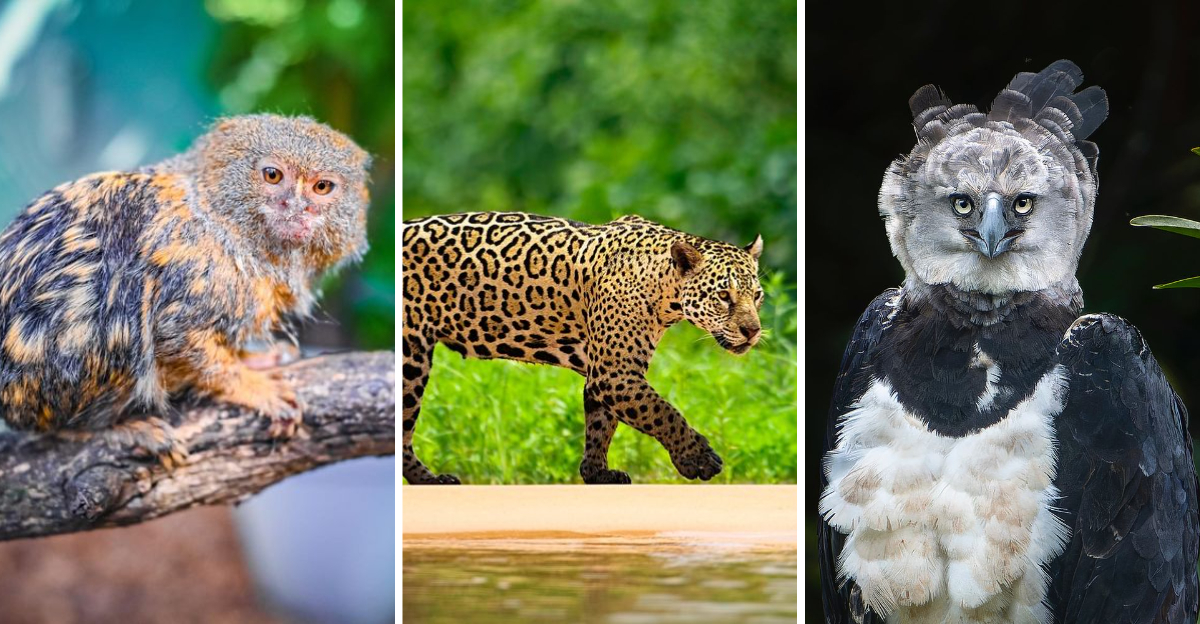The Amazon Rainforest, a sprawling expanse of lush greenery and winding waterways, is home to one of the most diverse and complex ecosystems on Earth. Hidden within its dense canopy and along its countless rivers are creatures so rare and extraordinary that they almost seem mythical.
Let’s take a closer look at some of these enigmatic species—animals that are not only fascinating but also steeped in mystery, intrigue, and the allure of the unknown.
From dazzling birds that display unimaginable colors to elusive predators that prowl silently in the shadows, these inhabitants of the Amazon offer us a glimpse into a world as remarkable as it is fragile.
1. Amazonian Tree Boa
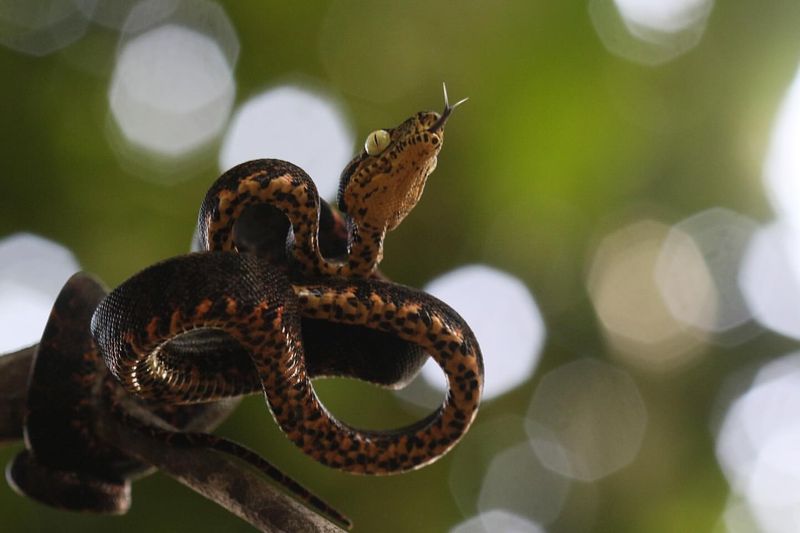
The Amazonian Tree Boa is a master of camouflage in the dense rainforest. Its vibrant scales, often a blend of greens and browns, allow it to blend seamlessly into its surroundings as it coils around branches. This elusive snake is a nocturnal hunter, preying on small mammals and birds with precision. Despite its fearsome appearance, it is non-venomous and poses no threat to humans.
Instead, it relies on constricting its prey, a skill it has perfected over millennia. Silent and solitary, the Amazonian Tree Boa epitomizes the mysterious allure of the rainforest. Its enigmatic presence adds to the rich tapestry of Amazonian wildlife.
Observation of this creature in its natural habitat offers a glimpse into the adaptive strategies employed by rainforest dwellers. Conservation efforts are crucial to protect this species, as habitat loss threatens its survival. With its unique adaptations, the Amazonian Tree Boa is a symbol of the rainforest’s incredible biodiversity and evolutionary wonders.
For those lucky enough to glimpse it in the wild, it leaves an indelible impression that underscores the importance of preserving these irreplaceable ecosystems.
2. Pink River Dolphin
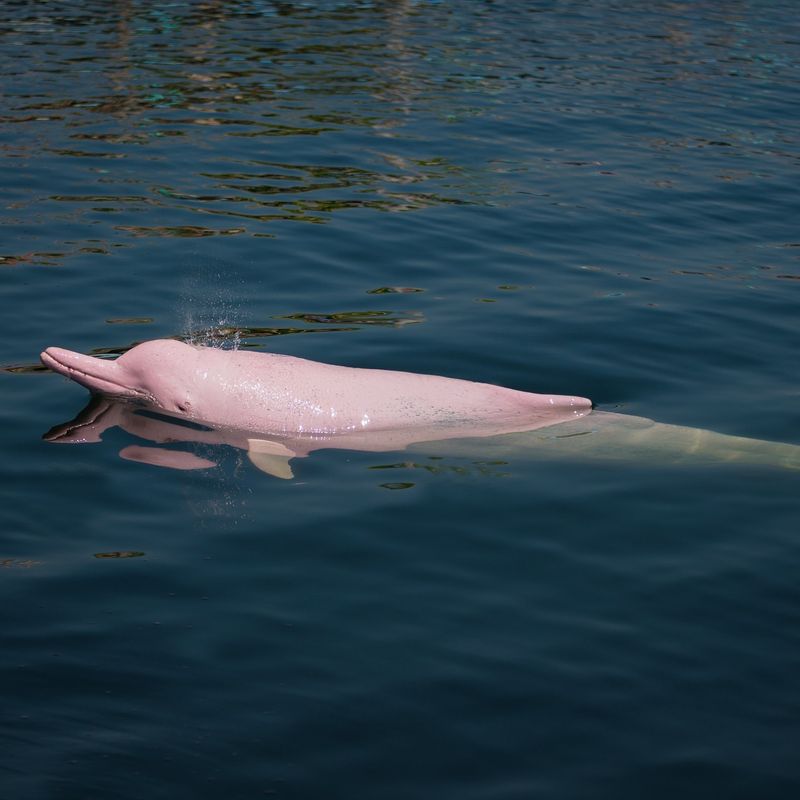
In the swirling waters of the Amazon, the Pink River Dolphin swims with an almost otherworldly grace. Its unique pink hue, which varies in intensity, sets it apart from any other dolphin species. This fascinating creature is highly intelligent, exhibiting behaviors such as complex social interactions and playful antics.
Unlike its marine counterparts, the Pink River Dolphin has adapted to the freshwater environment of the Amazon Basin, navigating its murky waters with ease. Its flexible neck allows it to maneuver skillfully around submerged obstacles.
The dolphin’s diet consists mainly of fish and crustaceans, essential for maintaining the ecological balance of its habitat. Observing a Pink River Dolphin in the wild is a rare and magical experience, offering a glimpse into the wonders of river life.
However, pollution and habitat destruction pose significant threats to its population. Conservation efforts are imperative to ensure the survival of this enchanting species. By supporting sustainable practices and raising awareness, we can help protect these beautiful creatures for future generations to admire and enjoy.
3. Glass Frog
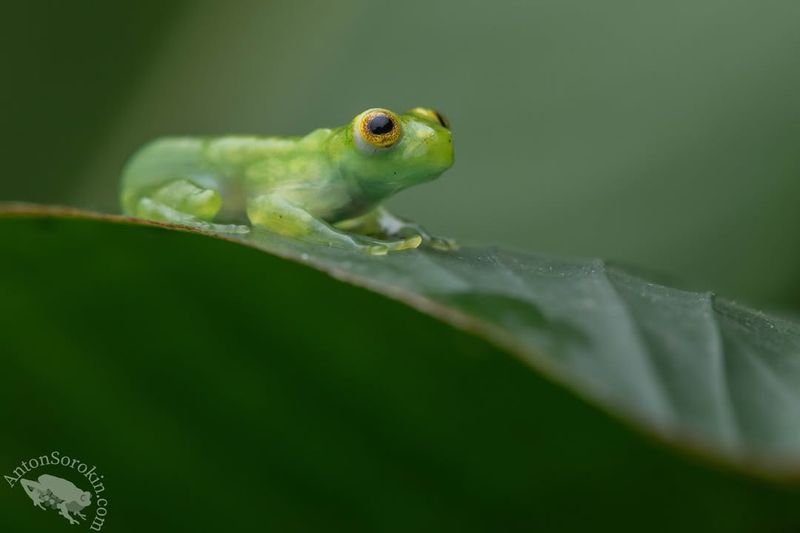
Perched on the vibrant leaves of the Amazon rainforest, the Glass Frog is a true marvel of nature. Its skin is so transparent that its internal organs are visible, a feature that fascinates scientists and nature enthusiasts alike.
This transparency serves as an effective camouflage, allowing the frog to blend into its environment seamlessly. Primarily nocturnal, the Glass Frog is most active during the night, when it embarks on its hunt for insects.
Its delicate appearance belies its resilience, as it has adapted to thrive in the humid, dense forest. The Glass Frog’s reproductive habits are equally intriguing. Females lay their eggs on foliage overhanging streams, and once hatched, the tadpoles drop into the water below, continuing their life cycle.
This unique approach to reproduction ensures their offspring’s safety in the early stages of life. However, habitat loss and climate change threaten their existence, making conservation efforts essential. Observing a Glass Frog in its natural habitat is a rare and captivating experience, reminding us of the delicate balance within the rainforest ecosystem.
4. Harpy Eagle
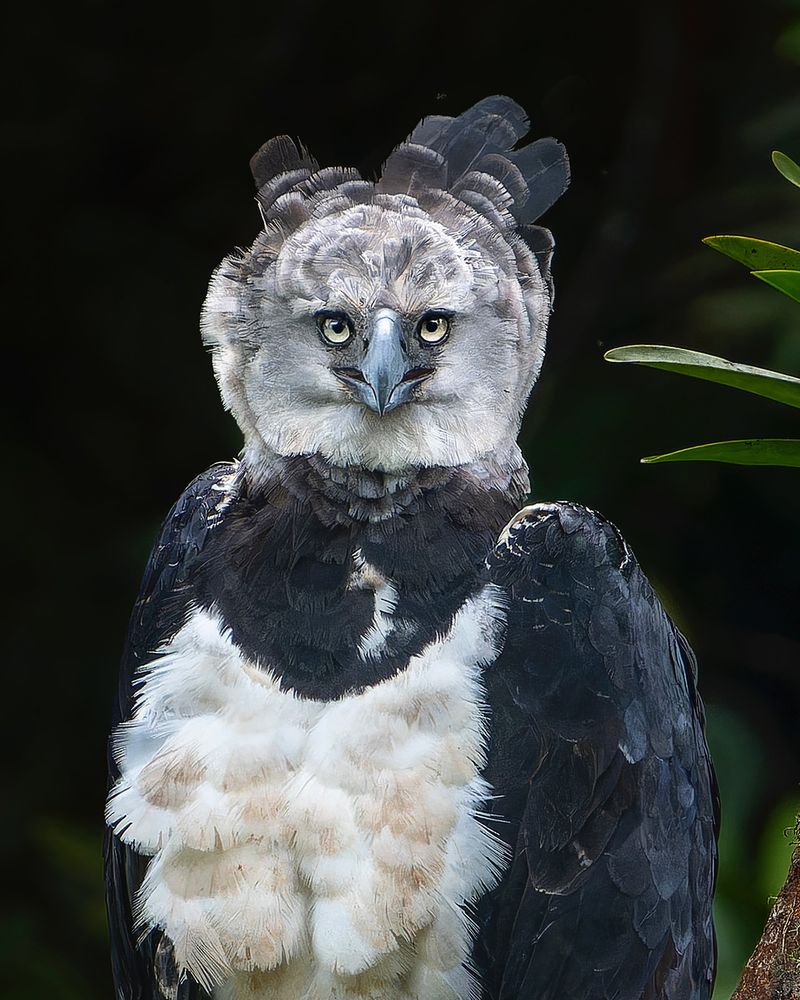
High in the canopy of the Amazon rainforest, the Harpy Eagle reigns supreme as one of the top predators. Its powerful build and striking plumage make it an awe-inspiring sight. With a wingspan that can reach up to seven feet, this majestic bird is a master of the skies.
It preys primarily on tree-dwelling mammals such as monkeys and sloths, showcasing its incredible hunting prowess. The Harpy Eagle’s keen eyesight allows it to spot prey from great distances, making it a formidable hunter.
Despite its dominance, this magnificent bird faces threats from habitat destruction and poaching. Preservation of its forest home is critical for its continued survival. Conservation programs aim to protect the Harpy Eagle and its habitat, ensuring that this apex predator remains a vital part of the rainforest ecosystem.
For those fortunate enough to witness it in flight, the Harpy Eagle leaves a lasting impression of strength and grace. Its presence is a reminder of the intricate balance within the Amazon and the importance of protecting these majestic creatures.
5. Poison Dart Frog
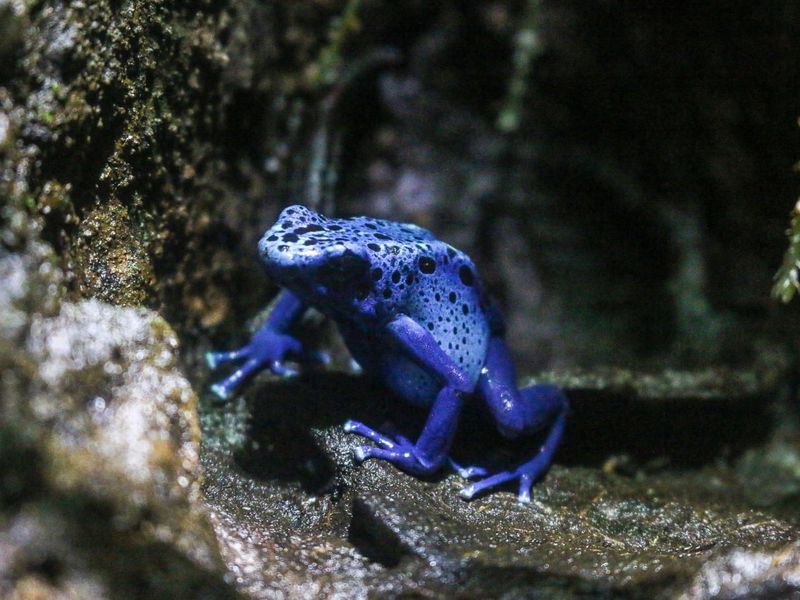
The Poison Dart Frog, with its vibrant colors, is one of the most iconic creatures of the Amazon rainforest. Its striking hues serve as a warning to predators of its toxic nature, a remarkable example of nature’s warning signals.
These small but potent amphibians possess skin toxins that can be lethal, a defense mechanism that deters even the most daring of predators. Found in the lush undergrowth of the rainforest, Poison Dart Frogs are a sight to behold.
They thrive in the humid environment, where they hunt for small insects and other invertebrates. Their toxins have been used by indigenous tribes for centuries, applied to the tips of blow darts for hunting. Despite their dangerous reputation, these frogs are fascinating subjects of study for researchers exploring the medicinal potential of their toxins.
However, habitat loss and climate change pose significant threats to their populations. Conservation initiatives are essential to protect these extraordinary creatures and their habitats. Observing a Poison Dart Frog in its natural environment is a thrilling experience, offering insight into the wonders of Amazonian biodiversity.
6. Arapaima
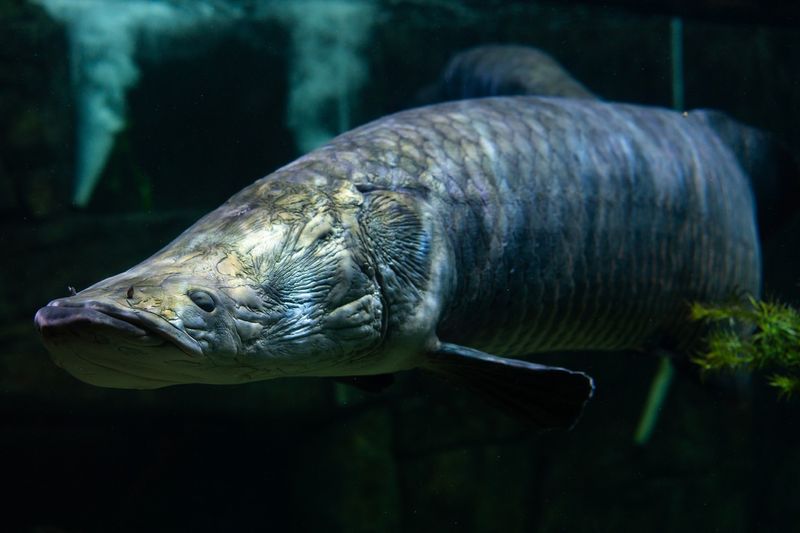
The Arapaima, one of the largest freshwater fish in the world, is a formidable resident of the Amazon River. Reaching lengths of up to ten feet, this giant fish is a remarkable specimen of aquatic life. Its elongated body and armor-like scales make it well-adapted to its environment.
The Arapaima is an air-breather, requiring it to surface regularly to gulp air, a unique adaptation among fish. This behavior allows it to thrive in oxygen-poor waters where other fish might struggle. Feasting on fish and crustaceans, the Arapaima plays a crucial role in maintaining the ecological balance of its habitat.
Its presence in the Amazon River is a testament to the rich biodiversity found within these waters. However, overfishing and habitat destruction threaten its survival. Conservation efforts are necessary to protect this iconic species and ensure the health of the Amazonian aquatic ecosystem.
Observing an Arapaima in the wild is a rare and awe-inspiring experience, showcasing the incredible variety of life that the Amazon River supports.
7. Jaguar
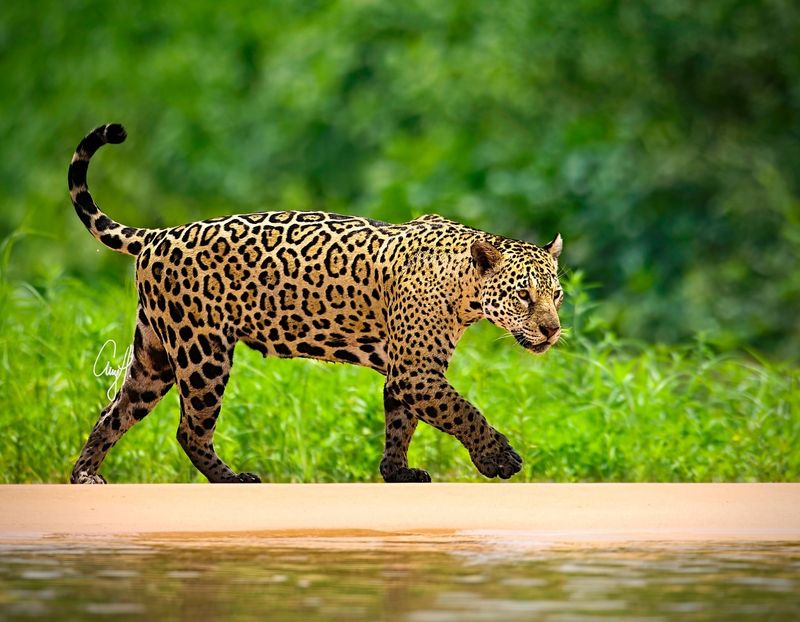
Within the shadowy depths of the Amazon rainforest, the Jaguar prowls as an unmatched apex predator. Its powerful build and stunning spotted coat make it an icon of the jungle. Jaguars are elusive and solitary, preferring to hunt alone under the cover of darkness.
They are equipped with strong jaws and sharp teeth, capable of taking down prey much larger than themselves. This adaptability makes them formidable hunters, preying on a diverse range of animals, from capybaras to caimans.
Despite their prowess, Jaguars face significant threats from habitat loss and poaching. Conservation efforts are vital to ensuring their survival, as these majestic cats play a crucial role in maintaining the ecological balance.
The Jaguar’s presence in the rainforest is a sign of a healthy ecosystem, highlighting the importance of preserving their natural habitat. Encountering a Jaguar in the wild is a rare and unforgettable experience, a reminder of the incredible diversity and beauty of Amazonian wildlife.
8. Sloth
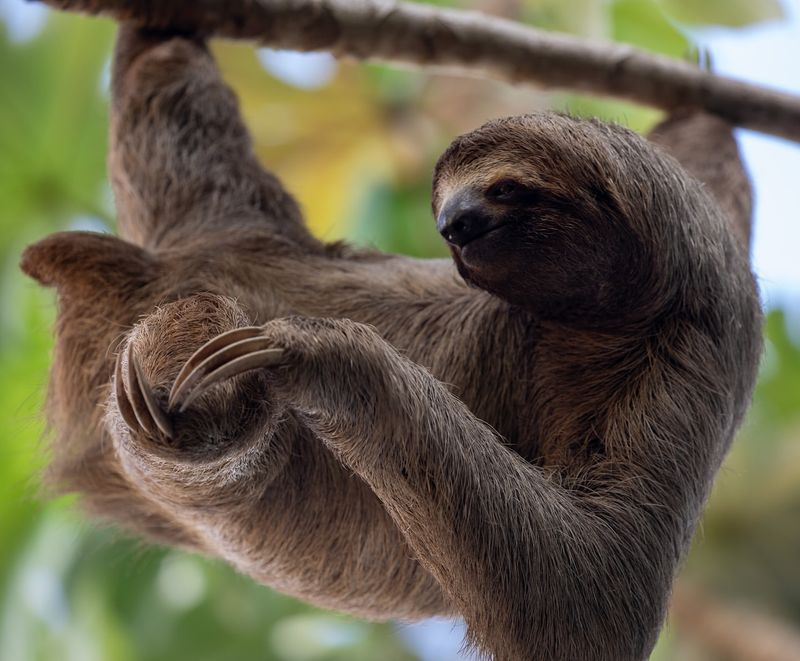
Hanging languidly from the trees, the Sloth is a symbol of the Amazon rainforest’s unique charm. Known for its slow movements, this gentle creature spends most of its life suspended from branches, conserving energy in the canopy.
Its shaggy fur hosts a unique ecosystem of its own, supporting algae and insects that provide additional camouflage. Sloths are herbivores, feeding primarily on leaves, which provide them with little energy, explaining their leisurely pace.
Despite their sedate lifestyle, sloths are skilled swimmers, able to navigate rivers when necessary. Their ability to remain still for extended periods helps them avoid predators, contributing to their survival strategy. However, deforestation and habitat fragmentation pose significant threats to their existence.
Conservation initiatives are crucial to protect these endearing creatures and their forest home. Observing a Sloth in its natural habitat offers a rare glimpse into the slow and peaceful rhythm of rainforest life, reminding us of the intricate connections within this vibrant ecosystem.
9. Pygmy Marmoset
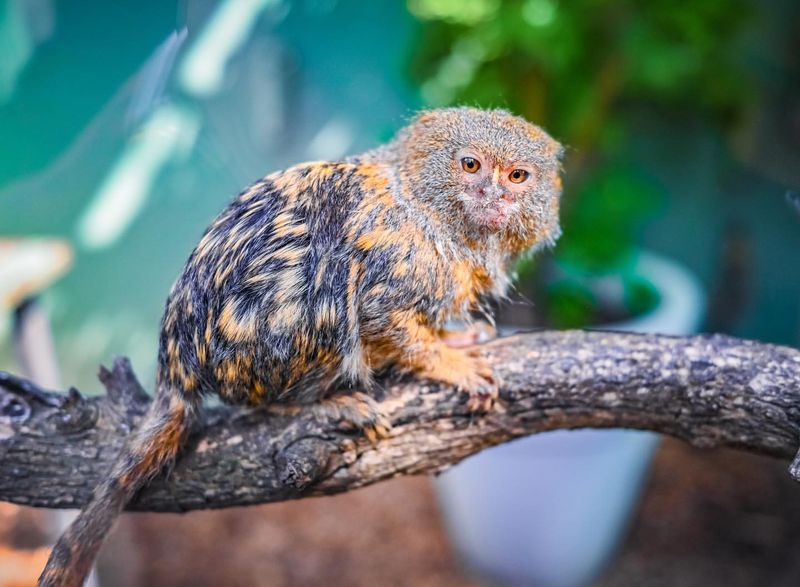
Clinging to the trees of the Amazon, the Pygmy Marmoset is the world’s smallest monkey and a captivating sight. This tiny primate, weighing around 100 grams, is remarkable for its diminutive size and agility.
Pygmy Marmosets live in small family groups, communicating with a range of vocalizations that facilitate social bonding. Their diet consists mainly of tree sap, which they extract using their specialized teeth. This dietary preference influences their choice of habitat, as they rely on trees that produce abundant sap.
Despite their small stature, these monkeys are incredibly agile, able to leap significant distances between branches. However, habitat destruction and the illegal pet trade threaten their populations.
Conservation efforts are essential to protect these unique primates and preserve their way of life. Observing a Pygmy Marmoset in the wild is a rare delight, offering insight into the fascinating world of Amazonian wildlife and highlighting the need for concerted conservation initiatives.
10. Amazonian Manatee
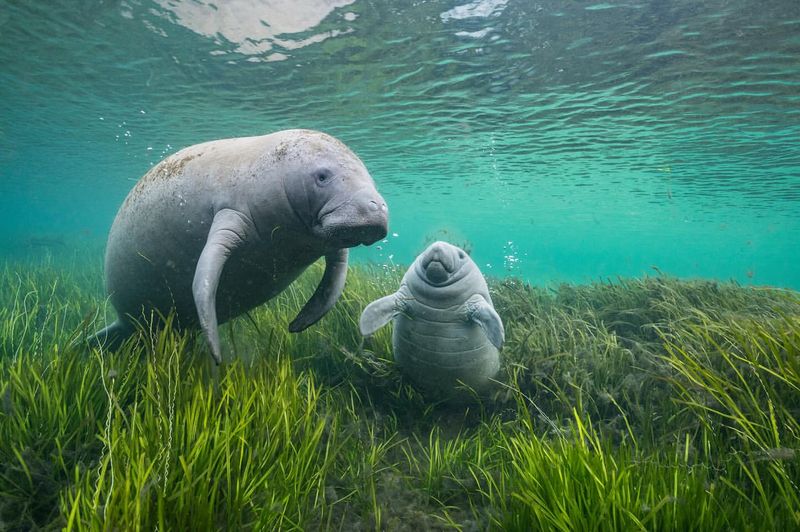
Gliding through the calm waters of the Amazon River, the Amazonian Manatee is a gentle giant of the aquatic world. These herbivorous mammals are known for their docile nature and slow movements, spending most of their time grazing on aquatic vegetation. Their round bodies and paddle-like flippers are perfectly adapted for life in the river.
Despite their size, Amazonian Manatees are elusive and often difficult to spot in the wild. They play a crucial role in their ecosystem, helping to maintain the balance of aquatic plant life. However, threats such as habitat loss, pollution, and illegal hunting pose significant challenges to their survival.
Conservation programs aimed at protecting the Amazonian Manatee and its habitat are vital to ensure its continued existence. Their presence underscores the importance of preserving these unique habitats for future generations.
11. Electric Eel
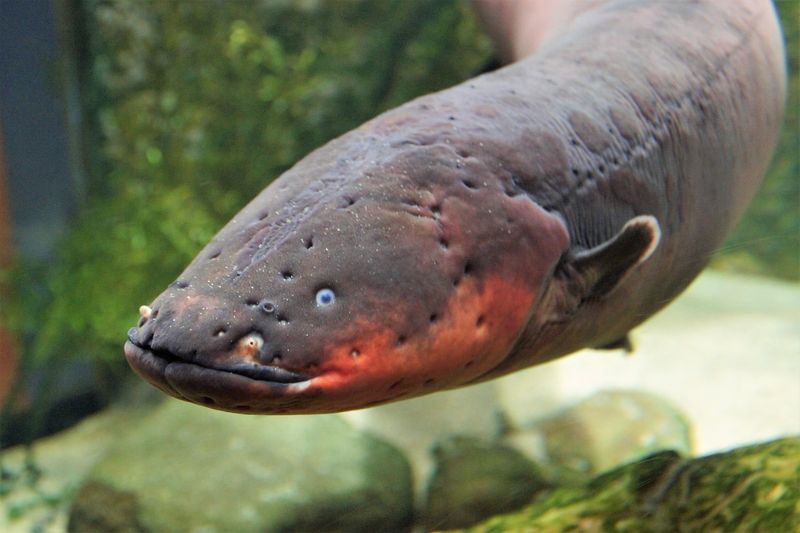
In the murky waters of the Amazon River, the Electric Eel reigns as one of its most fascinating inhabitants. Despite its name, the Electric Eel is not a true eel but rather a type of knifefish, capable of generating powerful electric currents.
These electrical discharges serve multiple purposes, from navigation and communication to stunning prey and deterring predators. The eel’s elongated body is uniquely adapted to its electric capabilities, housing specialized cells known as electrolytes.
Feeding primarily on fish and small invertebrates, the Electric Eel plays a significant role in its ecosystem. However, its habitat faces threats from pollution and human encroachment. Conservation efforts are essential to protect this unique species and its environment.
Its presence highlights the complexity and richness of life in one of the world’s most biodiverse regions.
12. Leafcutter Ant
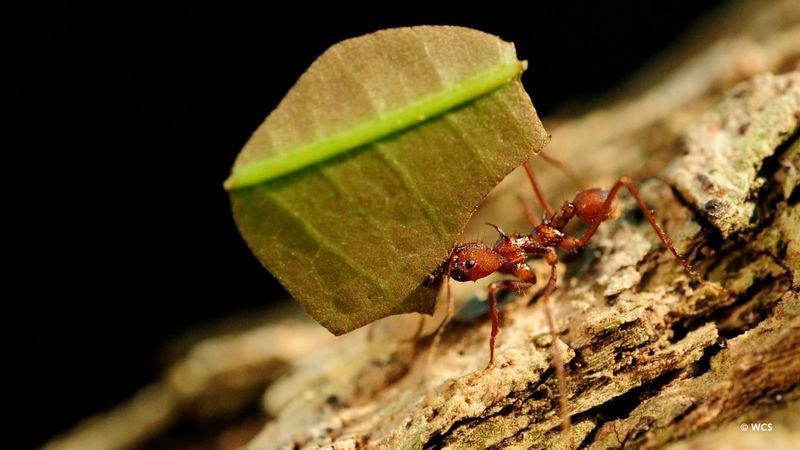
In the bustling undergrowth of the Amazon rainforest, Leafcutter Ants carry out their complex and organized activities. These industrious insects are known for their remarkable ability to harvest and transport large pieces of leaves back to their nests.
The leaves are not consumed directly; instead, they serve as a substrate for cultivating a special type of fungus, which the ants use as their primary food source. This agricultural practice makes Leafcutter Ants one of the few non-human species known to engage in farming.
Their colonies are highly organized, with millions of ants working together in a highly structured social system. Leafcutter Ants play a crucial role in their ecosystem, contributing to the decomposition of organic matter and the aeration of the soil.
However, they are also subject to threats from habitat destruction and climate change, which can impact their delicate balance with the environment.
Observing these ants in action is a captivating experience, offering a glimpse into the intricate social structures and survival strategies of Amazonian insects. Their presence in the rainforest underscores the complexity and interdependence of life in this vibrant ecosystem.
13. Amazonian Giant Centipede
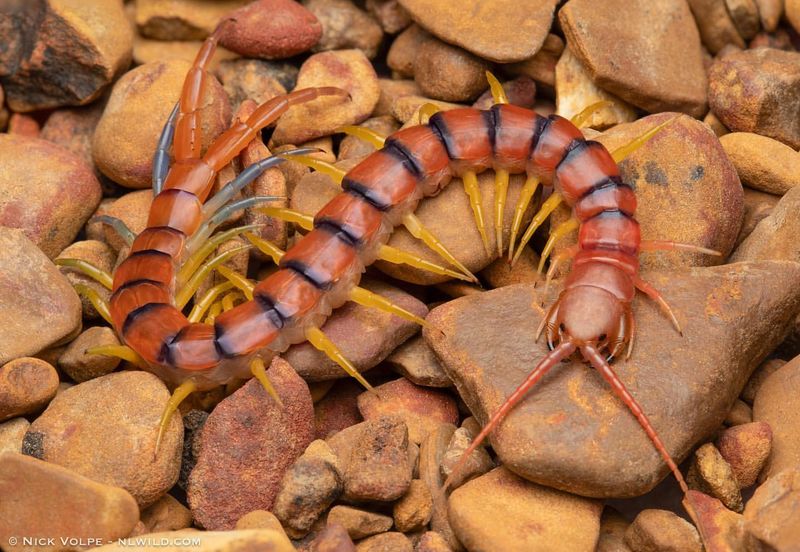
Crawling through the shadowy undergrowth of the Amazon, the Amazonian Giant Centipede is a formidable predator. With its numerous legs and elongated body, it moves with speed and agility, capable of capturing a wide range of prey, from insects to small mammals and reptiles.
This centipede’s venomous bite aids in subduing its victims, making it a feared predator despite its relatively small size compared to other Amazonian creatures. The Amazonian Giant Centipede is a master of survival, adapting to the diverse and challenging conditions of the rainforest floor.
However, its fearsome reputation often overshadows its ecological importance. As a predator, it helps control the populations of other small creatures, contributing to the overall balance of the ecosystem.
Seeing an Amazonian Giant Centipede in the wild is an exciting, albeit intimidating, experience, offering insight into the complex web of predator-prey relationships in the rainforest. Its presence is a reminder of the diverse and often hidden lifeforms that inhabit this rich and mysterious environment.
14. Anaconda
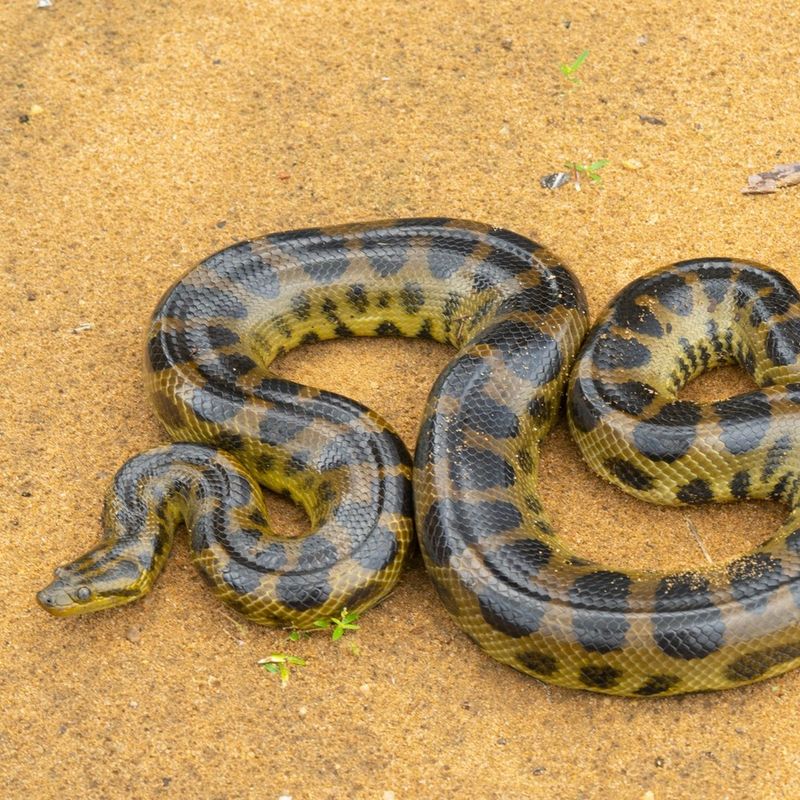
In the rivers and swamps of the Amazon, the Anaconda rules as one of the largest and most powerful snakes in the world. Its immense size and strength make it a formidable predator, capable of taking down prey as large as deer and caimans.
Despite its fearsome reputation, the Anaconda is an important part of the Amazonian ecosystem, controlling the populations of various animals. Its hunting strategy relies on stealth and patience, often waiting motionless for hours until the perfect moment to strike.
The Anaconda’s ability to blend into its watery environment makes it an effective ambush predator. However, habitat destruction and hunting pose significant threats to its population. Conservation initiatives are crucial to protect this iconic snake and its habitat.
Observing an Anaconda in the wild is a thrilling experience, offering a glimpse into the raw power and intricate adaptations of one of the Amazon’s most fascinating creatures. Its presence underscores the importance of preserving the diverse and delicate ecosystems of the Amazon rainforest.
15. Tapir
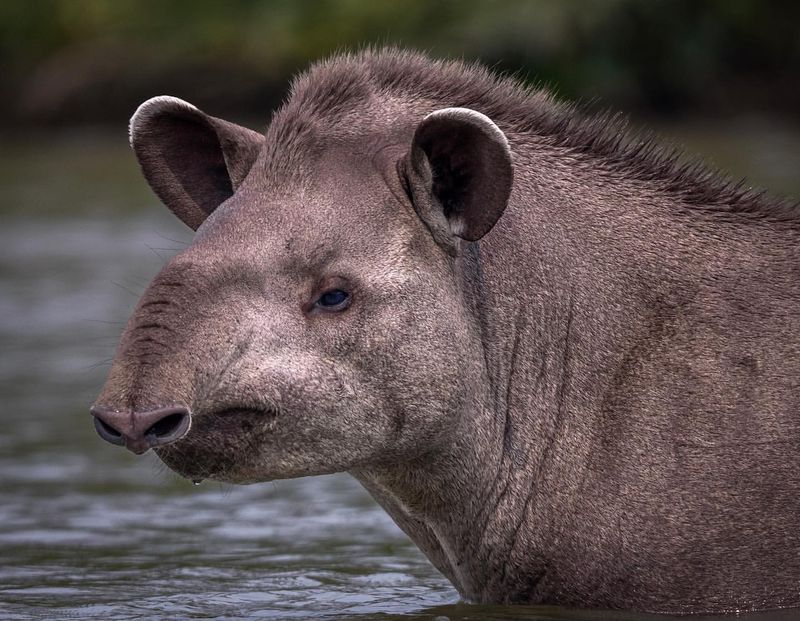
Wandering through the dense vegetation of the Amazon, the Tapir is a gentle yet elusive inhabitant of the rainforest. Its distinctive snout, resembling a short trunk, is used to forage for leaves, fruits, and aquatic plants.
Tapirs are primarily nocturnal, using their keen sense of smell to navigate through the dense forest under cover of darkness. Despite their size, they are surprisingly agile and can move quickly when necessary. Tapirs play a vital role in their ecosystem by aiding in seed dispersal, helping maintain the health and diversity of the forest.
However, they face threats from deforestation and hunting, which have led to declining populations. Conservation efforts are essential to protect these unique animals and their habitats.
Observing a Tapir in the wild is a rare and delightful experience, offering a glimpse into the hidden life of the Amazon rainforest. Their presence is a testament to the rich biodiversity and interdependent relationships that characterize this remarkable ecosystem.
16. Macaw
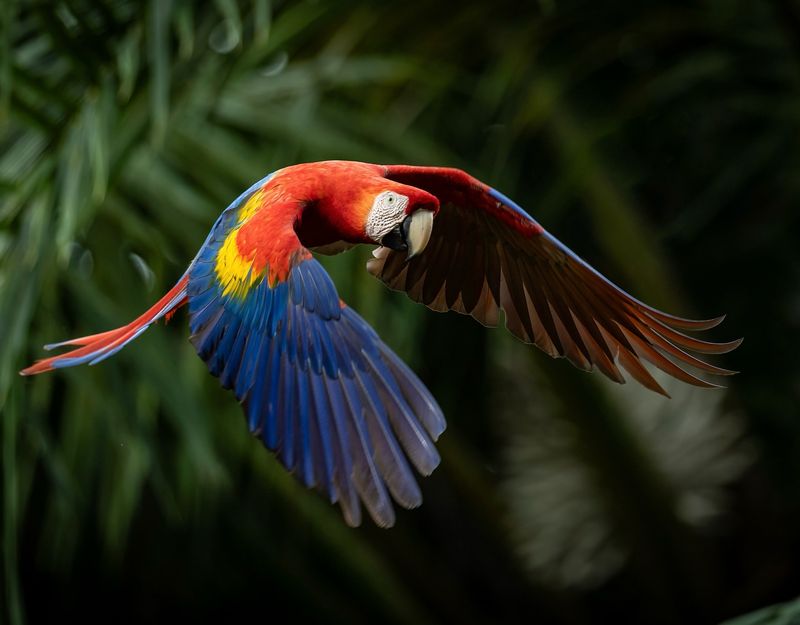
Perched high in the trees of the Amazon, the Macaw is a vibrant symbol of the rainforest’s incredible biodiversity. Known for their strikingly colorful plumage, these intelligent birds captivate observers with their beauty and social behaviors.
Macaws are highly social creatures, often seen in pairs or flocks, communicating with a range of vocalizations that echo through the forest. Their strong beaks are perfectly adapted for cracking open nuts and seeds, which form the bulk of their diet.
Macaws play a crucial role in their ecosystem, aiding in seed dispersal and contributing to the health of the forest. However, habitat destruction and the illegal pet trade threaten their populations, making conservation efforts vital.
Observing a Macaw in the wild is a breathtaking experience, offering insight into the rich tapestry of life in the Amazon. Their presence is a reminder of the vibrant and diverse wildlife that depends on the rainforest and the importance of preserving these habitats for future generations.
17. Capybara
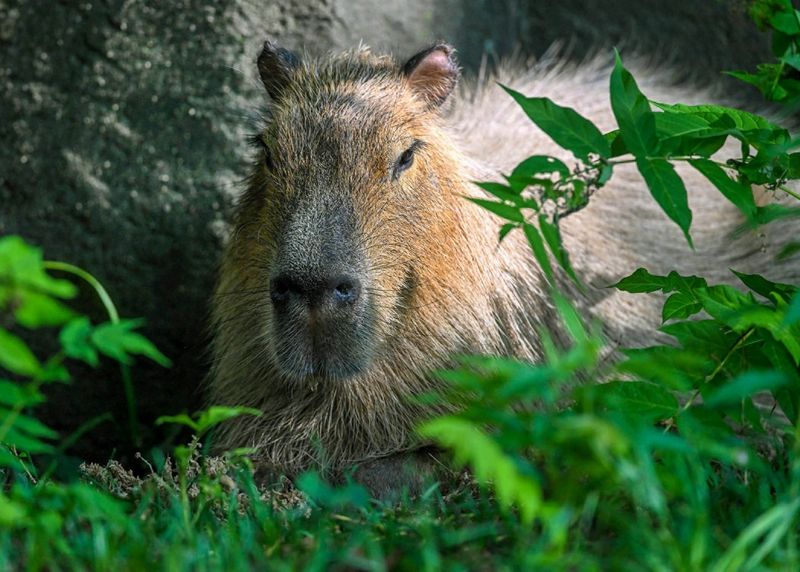
Lounging by the riverbanks of the Amazon, Capybaras are the world’s largest rodents and a charming sight in the rainforest. These social animals live in groups, often engaging in communal activities such as grooming and sunbathing.
Their semi-aquatic lifestyle allows them to thrive in the rainforest environment, with webbed feet that make them excellent swimmers. Capybaras feed on a variety of grasses and aquatic plants, playing a key role in their ecosystem by helping maintain the balance of vegetation.
Despite their size, Capybaras are gentle creatures, often seen coexisting peacefully with other wildlife. However, they face threats from habitat destruction and hunting.
Conservation efforts are essential to protect these endearing animals and their way of life. Observing Capybaras in their natural habitat is a heartwarming experience, offering a glimpse into the harmonious and interconnected world of the Amazon rainforest.
18. Tamarin
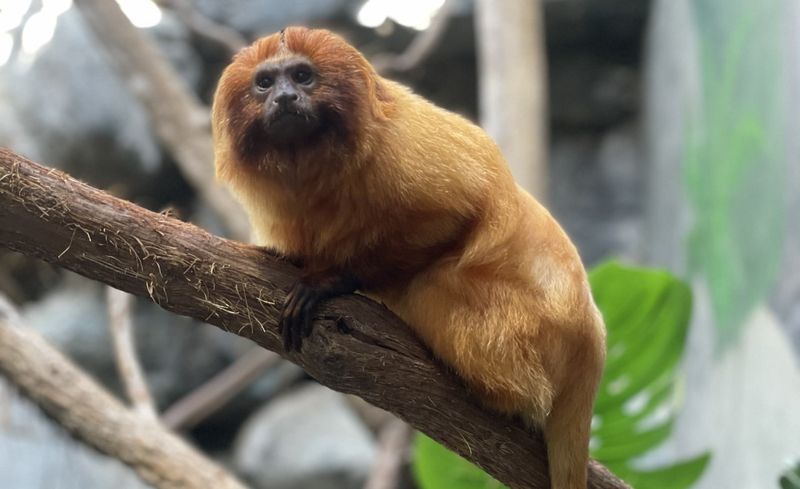
Perched among the trees, the Tamarin is a small yet striking inhabitant of the Amazon rainforest. Known for their vibrant coats and expressive faces, Tamarins are social creatures, living in family groups that work together to care for their young.
Their diet consists of fruits, insects, and small vertebrates, which they forage with agility and precision. Tamarins play a crucial role in seed dispersal, aiding in the regeneration of the forest.
However, habitat destruction and the illegal pet trade threaten their populations, highlighting the need for conservation initiatives. These small primates are a symbol of the delicate balance within the rainforest ecosystem and the interconnectedness of its inhabitants.
Observing a Tamarin in the wild is a joyous experience, showcasing the beauty and complexity of life in the Amazon. Their presence reminds us of the importance of preserving biodiversity and protecting these unique habitats for future generations to enjoy.
19. Goliath Birdeater
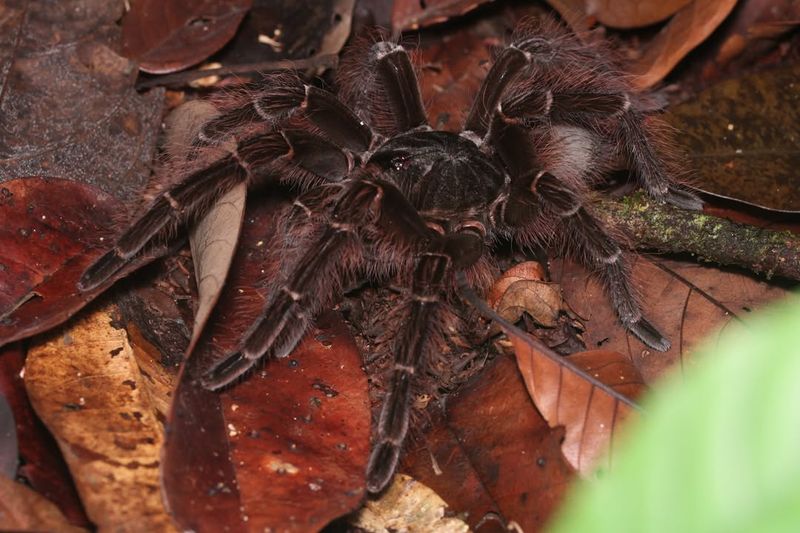
Creeping across the forest floor, the Goliath Birdeater is the largest tarantula in the world and a formidable presence in the Amazon rainforest. Despite its intimidating appearance and name, it rarely preys on birds, instead feeding on insects, small mammals, and reptiles.
This tarantula’s massive size and hairy body make it instantly recognizable, while its venomous bite, though not lethal to humans, aids in subduing prey. The Goliath Birdeater’s role as a predator helps control the populations of other small creatures, contributing to the ecological balance.
However, habitat loss and human encroachment threaten its existence, emphasizing the need for conservation efforts. Observing a Goliath Birdeater in the wild is both thrilling and humbling, offering a glimpse into the diverse and often hidden life of the rainforest.
Its presence is a testament to the incredible variety and adaptability of Amazonian wildlife, reminding us of the importance of preserving these unique ecosystems.

